Topics in Ceramics: History of Ceramics I
Professor: Michele Fricke
Ceramics production in France was rare prior to the 17th century. Although a thriving pottery community was established in Italy, and Italian potters came to France to visit and work, the French were not particularly interested in producing ceramic wares in their own country. [1] Oriental porcelain, made out of native clay and rocks, however, was precious and was found only in the salons of the Kings and Queens of Europe. Real porcelain remained a rarity throughout the Renaissance. Even though many countries tried to produce their own hard-porcelain, it could never come close to the white and translucent qualities the oriental porcelain had.
The Chinese used “kaolin,” which is refined clay, which they mixed with a feldsparic rock called “petuntse”. Fired at a high temperature, about 1400 degrees Celsius, these melt together and form a translucent white clay body.[2] The European imitation was often earthenware with white enamel, which lacked the elegance, translucency and lightness of the Chinese and Japanese products, and only fooled the eye to believe that the same quality had been achieved. The imitation was sponsored by the Medici family in Florence in the late 16th century and was called “faïence”, or soft porcelain.[3]
In 4000 BCE, faïence was invented by the Egyptians to simulate glass and precious stones. It was a cheap alternative to turquoise jewelry and is often referred to as Egyptian paste. The paste was made by mixing ground-up quartz with certain minerals like sodium, potassium, calcium, and magnesium. They used manganese to achieve a black or purple color, cobalt for blue, and lead antimonite for yellow.[4] Malachite Ore, which contains copper oxides, was sometimes used instead of quartz, and it gave the faïence a blue-green color. Water was added and the paste was then molded into small objects and pots. Faïence could not be thrown. When fired, the minerals that were transported to the surface with the water that evaporated during the drying process, form a crust on the outside, called efflorescence. That created a glossy surface, like glass, but these faïence pieces were very porous on the inside. The Egyptians made Jewelry out of these pieces, but also tiles and little funeral figurines, called “shabtis”[5].
The French used the term “faïence” later to describe their earthenware with a tin glaze.[6] Producing faïence was very expensive, more expensive than using real porcelain. It was more labor intensive to produce wares in faïence and a lot of these pieces were lost during the firings. Oftentimes the wares were produced very clumsy and dull, so a lot of gold was applied to hide the fact that the materials used for making faïence were not of the highest quality. However until Kaolin deposits were discovered in France, the use of faïence flourished and some of the faïence pieces were made exceptionally well and garnered much respect.
Early on some began using a white clay body, which was the first step toward developing a porcelain body equivalent to the porcelain exported from China and Japan. However, it did not match the quality that came from the East. Today, the pieces with the experimental white clay body that have survived are very valuable, even though, compared to real porcelain wares “the glaze is seldom very brilliant, the body is only moderately translucent, and the colour of the whole is somewhat dull and yellow.”[7]
Before porcelain symbolized “the wealth, status and taste of those who owned it”[8] in the 18th Century, the industry flourished in Northern and Central Europe, especially in Holland, Scandinavia, and Germany. Holland developed its famous “Delft” wares, a white and blue tin-glazed earthenware pottery. The artists of this faïence originally tried to copy the Oriental porcelain wares, which were imported from China and Japan in the 17th century. Ultimately, the Dutch developed their own style and mark.[9] In Scandinavia there were several porcelain factories, which include Copenhagen (1722-1814) in Denmark, and Rörstrand (1725), Stralsund (1755-92) and Marieberg (1758-88) in Sweden. These companies each had their individualized style and made wares from faïence and porcelain.[10] Germany started the first hard porcelain production with the Meissen Porcelain near Dresden in the early 1700’s. In 1707 Ehrenfried Walther van Tschirnhaus, a scientist, and his assistant, Johann Friedrich Böttger, an alchemist, discovered a recipe to produce a hard red porcelain and, a year later, a hard white porcelain.[11] “[T]he factory at Meissen was like a fortress, whose secrets were kept to the death, and where every traitor was punished with life-long imprisonment.”[12] Its baroque style figurines, vases, and table settings were popular throughout all of Europe. Consequently “nearly all [of] the rulers of the German Reich’s many small states wanted to set up their own porcelain works based on the Saxon model.”[13] Meissen was probably the most influential porcelain factory in all of Europe. Its style was copied throughout the years, and these copies were sold cheaply all over the world. The original porcelain pieces, however, are unparalleled and remain very valuable. The Staatliche Porzellan-Manufaktur Meissen GmbH is still in business today and its “products are still orientated to the formal language of Dresden baroque and the chinoiserie so popular at that time.”[14]
Trade routes to the Cape of India allowed more Oriental porcelain wares to enter the French market, and a real need to produce these fine wares in France was postponed. Since the Catholic Church had a big influence on the arts at that time, establishing pottery, or ceramics, as a fine art was difficult. “Doubtless, the art of working in clay had been considered too clumsy and too rude to entitle it to extensive use in the decoration of churches, or for the production of the rich accessories used in ceremonial observances. In fact, all the pyxes, the vessels, the crosses, the shrines, and the ornamental plate, used in the services of the church, were of gold and silver, often covered with enamels.”[15] Later, when all of the money was spent on wars, and the French nobility had to melt their silver plates to fund weapons, the pottery craft began to be seen as a necessity. In the middle of the 18th century, a market for French porcelain as art was finally established, and the search began for a hard-porcelain, white, translucent, and fine, much like the one from China and Japan. In 1664, an art dealer named Claude Reverend, who imported the famous Delft wares from Holland into France, claimed that he could make a great faïence that would imitate the porcelain from China and Japan perfectly. Louis VIX granted him “(t)he monopoly of this manufacture and importation […] for the term of fifty years, and [everyone] was forbidden, under pain of confiscation of their goods and a penalty of 10,000 livres, to make or sell this porcelain within thirty miles of Paris.”[16] The truth of that claim, however, was never proven. Other people sought the same privilege and were granted the right to travel and import wares from other countries, to study and to develop a formula for porcelain, from which efforts some of the early porcelain productions initially started.[17]
Although ceramic production was limited in France during the 15th and 16th century, throughout the 17th and 18th century, ceramics blossomed all over the country. In every major city, a ceramic center opened and produced original wares made with great techniques. New discoveries were made in how to produce and finish pottery, examples of which can be seen in many museums throughout the world. The artists who produced these faïence pieces became very good at making and decorating their wares, and the quality increased through good craftsmanship and great artistic skills. Aprey, Arras, Bordeaux, Chantilly, Desvres & Hesdin, Lille, Limoges, Mennecy, Montauban, Montpellier, Orleans, Paris, Quimper, Rennes, Saint Amand, Saint Cloud, Saint Omer, Samadet, Sceaux, Sinceny, Valenciennes, and Varages[18] were porcelain manufacturers located all over France. Some of these companies would produce soft paste, and then later on, hard paste porcelain wares, others specialized in one form of porcelain only. Each company was greatly influenced by such important ceramic centers as Nevers in central France, Rouen in the North, Moustiers and Marseilles influencing the South, and Strasburg in the East.[19] Skilled artisans left one company to join another, and oftentimes they brought valuable knowledge with them from their previous employer. Therefore, many other styles were simply copied, and some companies never made their own wares but simply recreated other manufacturers’ works.
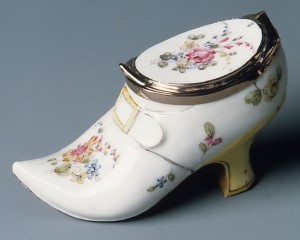 Figure 1: Snuffbox, Date: 1750–60, Culture: French (Mennecy), Medium: Soft-paste porcelain, gold, Dimensions: L. 3 9/16 in. (9.0 cm.). Signatures, Inscriptions, and Markings: Indecipherable mark on gold rim of shoe |
The Villeroy/Mennecy Company produced mainly decorative sculptural pieces, made from Faïence, as early as the 1680’s. These figurines were made in a “pseudo Oriental style, but in the palette of soft pink, pale blue, brown, yellow, and two shades of green typical of Mennecy.”[20] Not many pieces can be identified as coming from the Mennecy. Few have been signed and their line of work mostly copied other companies’ work, such as Sèvres and Meissen, especially the monkey figures. One of Mennecy’s signature style from the 1750’s that no other factory produced in the 18th century was very ornate wares, in the style of Chinese and Japanese porcelain figures, with a specific function. These decorative pieces would serve as candle holders or were designed to hold potpourri or tobacco (Figure 1). They were produced for market of “decorative objects that also served a function in the boudoir or drawing room.”[21] Mythical figures became popular in England in the 1760’s, and Mennecy copied this subject matter in their figurines as well.
The town of Nevers was greatly influenced by Italian ceramics, since it was governed by Italians who came to Nevers by marriage. As one of the oldest manufacturers, Nevers’ ceramic production focused mainly on copying other ceramic centers. Whatever Nevers copied, its work was exceptional. It copied the forms and ornamentations of its competitors, such as Rouen, Moustiers, and Strasburg[22], and was in return copied by them.[23] When it first opened in 1740, Nevers was inspired by traditional rustic Italian pottery, and they produced
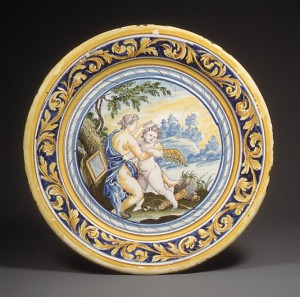 Figure 2: Plate, After an engraving by Odoardo Fialetti (Italian, Bologna 1573–1637/38 Venice), Date: mid-17th century, Culture: French (Nevers), Medium: Faience (tin-enameled earthenware), Dimensions: Diam. 10 in. (25.4 cm). Provenance: Gaston Le Breton (before 1910) |
many of these wares. It created fine statues of saints and virgins, and painted scenes of trees, ornaments and flowers, which were drawn on blue faïence (Figure 2). Later they started copying the Persian style; birds, plants and flowers were colored with a “rich azure-blue, relieved by designs in iridescent whites and yellows.”[24] Then they copied the Japanese and Chinese wares, which had been imported to France. Their imitations were good quality and could hold up to the ceramics pieces that came from the orient. They did reach a stage where they became more original. Mythical subjects became outdated, and they designed a more national sense of decoration. They were still copying their French and Dutch competitors, but the decoration now had a sense of Nevers, and they called it the Franco-Nivernese style.[25] “M. Gouellain, Amateur of Faïence”[26] writes in the 1640’s: “” [w]e have come […] to an epoch in the history of art the traditions of which continue [in] force until the middle of the eighteenth century. Naiads, artistically descended from those of the Farnesina frescoes, alternate with Dutch drinkers in the decoration of comparatively large pieces. Now masks or rams’ heads stand out from the pediment of some colossal fountain or ornamental vase; now pot-bellied Chinamen strut about on wide-brimmed dishes, recalling with more elegance and less monotony the favourite style of Delft.””[27]
The painters of Nevers were especially inspired by the late renaissance and baroque painters Poussin, Van Dyck, and Vouet.[28] These original wares lasted only a short period of time, and, by the 18th century, they returned to copying their competitors, especially Rouen, but were apparently limited by their restricted color palette that missed the color red. Why this color was never discovered is not clear. They also overfired their wares, which caused much of the detail to be lost in the firing process.[29] Nevers went out of business when, in 1789, a treaty with England allowed the introduction of English pottery, mostly cheap and affordable, all over France. Although people fought against this clause of the treaty, and an estimated 32,500 people lost their jobs, “the protest was ineffective. The damage begun by imports from Britain was completed by the makers of ‘faïence fine’ on French soil; in 1800 there were few ordinary faïence factories left and by 1850 the industry was practically extinct.”[30]
The first production of hard porcelain in France occurred in the pottery factory in Rouen in 1673, when Louis Poterat sought a permit to make hard porcelain just like the Chinese and Japanese had done. Although Poterat’s experiments did not achieve a clay body comparable to porcelain from Northern Europe or the East by all means. Rouen did not pursue a closer investigation into hard-porcelain, but became famous for fine faïence wares.[31] Initially, the Rouen factory copied the style of Nevers and Holland but soon developed its own style of applying a decoration directly onto the raw, unfired glaze, and not, as was commonly done, under the glaze, onto the bisque ware. “When one is able to see a group of pieces of Rouen porcelain as [in] the collection of M. le Comte de Chavagnac, which is especially rich in French soft-porcelains, the Rouen pieces immediately strike one by their very slightly sea-green glaze, their rich and creamy paste, less amber-coloured than that of other early French porcelains, and by their blue decoration, which is often darker, and somewhat greyer than that used elsewhere.”[32] Rouen was referred to as the “Queen of French Pottery”[33]. It made every imaginable piece for the dining table, not just mugs, plates, pitchers, and teapots, but also mustard-pots, gravy boats, glasses, soup terrines and other usable wares.[34] Rouen’s influence in shape came mostly from metal works and was always symmetrical (Figure 3). The Rococo period, with its asymmetrical shapes and its lavish decoration, was never fully explored at Rouen.[35]
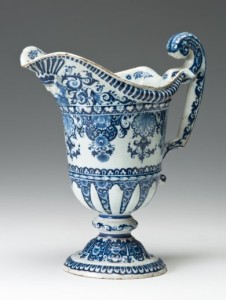 Figure 3: Ewer, Date: c. 1700, Culture: Rouen, France, Medium: Earthenware with tin glaze and enamel (grand feu faïence), Dimensions: 11 x 11 in. (27.94 x 27.94 cm). |
Moustiers was founded in the 1670’s and was a great influence on Southern France and Spain. It imitated the faïence wares from Nevers and Rouen. The women of Louis XIV’s court loved these wares, and, during war times, when the nobility and bourgeoisie had to bring their metal pieces to the mint to convert the metal into bullion, they replaced them with faïence pieces from Moustiers.[36] An interchange with the Alcora factory in Spain brought back the secrets of polychromatic faïence. The use of multiple colours became widely popular in France. Although, at first, “Alcora faïence in this and later fashions often resembles that of Moustiers very closely, […] its drawing is better and the reddish body material is distinct from the pale buff one used at Moustiers.”[37]
![Figure 4: Pair of potpourri vases, Veuve Perrin Factory (only one is pictured here), Date: ca. 1760, Culture: French (Marseille), Medium: Faience (tin-enameled earthenware), Dimensions: H. 18-1/2 in. (47 cm), Classification: Ceramics. Provenance: Count d'Estourmel ; Possibly Marius Bernard (1913–14) ; Gilbert Lévy (1919–20) ; [ Gaston Bensimon (sold to Wilson) ] ; R. Thornton Wilson (until 1950)](https://version2.melaniesherman.com/wp-content/uploads/2015/10/Marseilles_Vase-183x300.jpg) Figure 4: Pair of potpourri vases, Veuve Perrin Factory (only one is pictured here), Date: ca. 1760, Culture: French (Marseille), Medium: Faience (tin-enameled earthenware), Dimensions: H. 18-1/2 in. (47 cm), Classification: Ceramics. Provenance: Count d’Estourmel ; Possibly Marius Bernard (1913–14) ; Gilbert Lévy (1919–20) ; [ Gaston Bensimon (sold to Wilson) ] ; R. Thornton Wilson (until 1950) |
Moustiers and Marseilles were closely related, not only by location, but by family ties and the interchange of workers. It is often impossible to distinguish the wares of certain styles after the mid-18th century. Marseilles employed local talent and a school of painters. The paintings on the wares influenced their production more than the shape of the pieces.[38] Their painting style was highly influenced by the study of real life and, rather than copying other paintings, their drawings had a sense of looseness and balance. The work was reminiscent of the Chinese and Japanese drawings seen on many porcelain wares imported at that time (Figure 4).[39] Marseilles tried a new approach to its decorations by adding colors after a low-heat in a “muffle kiln,” thereby achieving a broader range of color.[40]
The Strasburg Porcelain Company was founded in 1721. At first, it copied the porcelain wares of Rouen, but, due to its close proximity to Germany, it soon started to look at German porcelain manufacturers. Its faïence porcelain pieces were made for export and were heavily influenced by the Rococo style, with asymmetric forms and swirly lines. The colors of the Rococo, crimson and rose pink, dominated the drawings. Their drawings did not compliment the forms, but were rather “tense and precise”[41] just like German porcelain. In the 1750’s former workers from Meissen brought the secrets of Meissen’s porcelain to Strasburg. Unfortunately, at that time, hard-porcelain was exclusively practiced at the Royal Porcelain Factory in Sèvres, where the style of drawing began to change and became known for a natural style of painting flowers, without outlines, but refined by shading and modeling (Figure 5).[42] Strasburg porcelain production ended in 1780, after the founder’s son mismanaged the company and lost the entire money of its investors.[43]
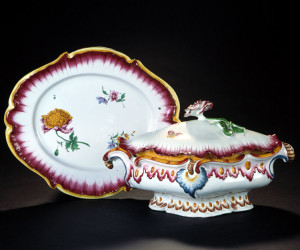 Figure 5: Strasbourg faïence terrine covered in “baroc” with handles in rocailles, and its display unit. Marked in blue under the display unit, PH for Paul Hannong. Circa 1754-1762. 18th Century. Length of the display unit 38.5 cm, width of the display unit 33 cm, height of the terrine 22 cm. The display unit with polychrome decoration of fine individual flowers according to the engraving of Jean-Baptiste Monnoyer about 1670-1680, large pink combed lines on the edges and a yellow line. The body is decorated with shells, combed and gadroons in relief. The heel is enamelled green. The lid is decorated with three butterflies and broad pink combed lines. The catch of the lid is in the shape of roses and foliages in relief. |
One of the most prestigious porcelain factories in France was Vincennes, which later became the Royal Porcelain Factory of Sèvres. The porcelain manufactory of Vincennes was founded in 1740 with workers from the porcelain factories of Chantilly. After copying the Orient and Meissen’s porcelain wares, it started to develop its own style of very fine faïence wares and quickly outgrew its facilities. It was relocated at Sèvres, and, in 1759, Louis XV purchased the entire factory, after which it was protected under the French crown. His mistress, Madame de Pompadour, revived the company and hired very skilled and artistic workers. Soon the Royal Manufactory of Sèvres became the “Queen of French porcelain”[44]. Sèvres started to specialize in extremely fine faïence ware. It was the purest and whitest faïence, superior to anything seen in France. Sèvres specialized in the production of ornamental and flowering vases[45], with very fine paintings, woodcarvings, luxurious ground colours
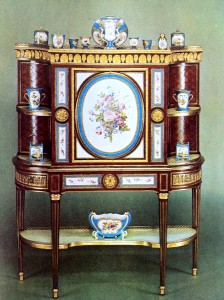 Figure 6: “Ormulu-Mounted and Sèvres Porcelain-mounted Louis XVI Pearwood Parquetry Secrétaire à Abbant” Date: Last Quarter 18th Century, Dimensions: Height 4 feet 2 ¼ inches (127.5 cm); width 40 inches (102.5 cm). Attributed to Martin Carlin. |
and richly tooled gilded decorations.[46] The fabrication of “porcelain-ornamented furniture”[47] also became popular (Figure 6). These decorative pieces were much admired at the French court, especially by the women. Marie-Antoinette became a patroness of Sèvres from 1771-74 and ordered furniture with inlaid plaques of porcelain and garnitures of all kinds. She preferred the simply decorated, white porcelain.[48] The Palace of Versailles had specified rooms for these most expensive French porcelain wares, and the end-of-the-year sale at the palace attracted not only the French aristocrats but collectors from around the world.[49] Louis XV started giving Sèvres porcelain as diplomatic gifts, and this tradition has continued to this day. Sèvres porcelain became desirable and precious around the world.[50] A sale depôt of art dealers in Paris also sold to collectors directly. These highly prized wares were especially popular in England. The Victoria & Albert Museum in London received numerous pieces of 18th Century French porcelain wares from Sèvres donated in the 19th and 20th Century.[51] King George IV of England was an avid collector of faïence pieces
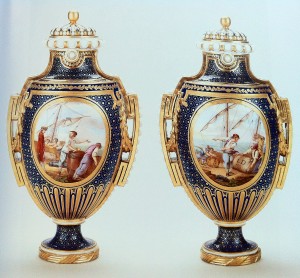 Figure 7: “Pair of Vases and Covers; Vase à Panneaux”, Date: c. 1766-1770, Culture: Sèvres, France, Material: Soft-paste Sévres porcelain, dark blue ground (Bleu Nouveau), painted by Jean-louis Morin (who used the lower case ‘m’ as his signature) in the late 1760’s or early 1770’s. Measurements: Heights: 30.5, Widths: 17.5 and 17.6, Depths: 13.8 and 13.9. |
made at Sèvres in France during his reign from 1783 until 1830 (Figure 7). He purchased many pieces to display them in his state apartment at his London residence, the Carlton House, as well as complete dinner and tea sets, which are still being used for ceremonial occasions.[52] Because many of these pieces were outside of France, they survived the French Revolution at the end of the 18th Century.
Hard porcelain made from local materials was not introduced into France until 1768, and wares of this china clay porcelain ware shifted the center of the French porcelain industry to Limoges. Many companies started to make tableware, since many monopolies and restrictions were imposed by the King with regard to working with the material.[53] Hard porcelain production had many advantages. It was less labor intensive, and there were far fewer losses in the firing process, as a result of both of which hard porcelain wares were much cheaper than faïence wares. New enamel colors and gilding techniques were invented, and, although more affordable, these early porcelain pieces were technically and artistically very good quality. The porcelain paste of Sèvres “was composed of kaolin and sand, to which a little chalk was also added, whilst the glaze consisted of quartz or sand, chalk, and fragments of broken porcelain, ground to an impalpable powder. This glaze was not nearly as glossy as that of the soft-paste porcelain; indeed, it was relatively opaque, so that the early hard-paste porcelain of Sevres has a very characteristic whiteness. Naturally the colours used on the soft-paste porcelain, which incorporated themselves so easily and so perfectly with the glaze, had to be modified to suit the new materials. Special colours and grounds were gradually developed for this purpose during the reign of Louis XVI [.]”[54]
With the many social and political changes and uproars in France, which would ultimately result in the French Revolution by 1789, Louis XVI was losing money. He tried to save the Royal Porcelain Factory of Sèvres by monopolizing the right to produce decorative hard porcelain wares, as well as certain processes and decoration styles made famous by Sèvres. However, the permits that had been given to certain people and companies could not be annulled, and Sèvres survived only because the King reduced the production in 1790. Sèvres continued, while most other porcelain factories did not. It became owned by the government of France after Louis XVI was executed, and its operation continues today.[55]
Although France was very slow to adapt to porcelain wares, soft, and hard paste, as an art form and for utilitarian use, some of the greatest ceramic pieces were produced throughout the 17th and 18th Century. Companies, such as Nevers, Rouen, Moustiers/Marseilles, Strasburg, and especially Sèvres, set the standards for the remainder of the 18th Century and are well known to this day for their decorative porcelain pieces. Although almost all companies closed as a result of the French revolution, the decline of France’s financial resources, or cheap foreign porcelain products flooding the French market, the legacy of French porcelain in the 18th Century lives on to this day, which speaks for its artistic brilliance and historic importance. Unlike the French monarchy, ceramic art created throughout the 17th and 18th Century not only survived but prevailed against time.
Bibliography
Auscher, E. S., and William Burton. A history and description of French porcelain. London: Cassell and company, 1905.
Avery, C. Louise. “European Ceramics Given by R. Thornton Wilson.” Metropolitan Museum of Art Bulletin, New ser., v. 15, no. 9 (May, 1957)
Cooper, Emmanuel. Ten thousand years of pottery. 4th ed. Philadelphia: University of Pennsylvania Press, 2000.
Coutts, Howard. The art of ceramics: European ceramic design, 1500-1830. New Haven, CT: Yale University Press, 2001.
Dawson, Aileen. “The Development of Repertoire in Mennecy Porcelain Sculpture, circa 1738–65.” Metropolitan Museum Journal, Vol. 37 (2002).
Dauterman, Carl Christian and Parker, James. “The Porcelain Furniture [The Kress Galleries of French Decorative Arts].” Metropolitan Museum of Art Bulletin, New ser., v. 18, no. 9 (May, 1960).
Frantz, Henri. French pottery and porcelain. London: G. Newnes, 1906.
Gwilt, Joanna. French porcelain for English palaces: Sèvres from the Royal Collection. London: Royal Collection Enterprises, Ltd., 2009.
Kupetz, Andrej. “A Manufacturing Renaissance – German Porcelain Blazes New Trails“. Goethe-Institut e. V. http://www.goethe.de/kue/des/prj/des/dth/en4011750.htm (December 2008)
Le Corbeiller, Clare. “China into Delft: A Note on Visual Translation.” The Metropolitan Museum of Art Bulletin, v. 26, no. 6 (February, 1968).
Lane, Arthur. French faïence. 2nd ed. London: Faber, 1970.
Maxwell, Christopher. French Porcelain of the Eighteenth Century. London: V&A Publishing, 2009.
Schreiber, Charlotte, Montague John Guest, and Egan Mew. Lady Charlotte Schreiber’s journals; confidences of a collector of ceramics & antiques throughout Britain, France, Holland, Belgium, Spain, Portugal, Turkey, Austria & Germany from the year 1869 to 1885,. London: John Lane, 1911.
Sparavigna, Amelie Carolina. “Faience: the ceramic technology of ancient Egypt”. Redazione Archaeogate. http://www.archaeogate.org/sperimentale/article.php?id=1508 (December 2012)
Images:
Figure 1: –.“Snuffbox”, ca. 1750-60, Mennecy, France. The Jack and Belle Linsky Collection, 1982. http://www.metmuseum.org/collections/search-the-collections/120023371. The Metropolitan Museum of Art. 28 Apr. 2013.
Figure 2: –. “Plate After an engraving by Odoardo Fialetti (Italian, Bologna 1573–1637/38 Venice)”, ca. 1750, Nevers, France. Gift of J. Pierpont Morgan, 1917. http://www.metmuseum.org/Collections/search-the-collections/120009022. The Metropolitan Museum of Art. Web. 28 Apr. 2013.
Figure 3: Einstein, Susan. “Ewer”, ca. 1700, Rouen, France. Gift of MaryLou and George Boone in honor of the museum’s twenty-fifth anniversary. http://www.lacma.org/art/exhibition/daily-pleasures-french-ceramics-marylou-boone. The Los Angeles County Museum of Art. Web. 28 Apr. 2013.
Figure 4: –. “Pair of potpourri vases”, ca. 1760, Marseille, France. Gift of R. Thornton Wilson, in memory of Florence Ellsworth Wilson, 1950, http://www.metmuseum.org/collections/search-the-collections/120025565?img=1. The Metropolitan Museum of Art. Web. 28 Apr. 2013.
Figure 5: –. “Terrine in faïence”, ca. 1754-62, Strasbourg, France. J.M. BEALU & FILS Antique Dealer, http://www.franceantiq.fr/sna/bealu/FaiencesUK.asp?classe=1&Lang=UK. Earthenware and porcelain J.M. BEALU & FILS Antique Dealer – PARIS. Web. 28 Apr. 2013.
Figure 6: –. “Ormulu-Mounted and Sèvres Porcelain-mounted Louis XVI Pearwood Parquetry Secrétaire à Abbant”, Last Quarter 18th Century, Sèvres, France. The Property of Mr. and Mrs. Deane Johnson of Bel Air, California. Sotheby’s, New York. Highly Important French Furniture Decorations and Extremely Fine Continental Porcelain. Sotheby Park Bernet, Inc., New York, 1972. 135. Print.
Figure 7: –. “Pair of Vases and Covers; Vase à Panneaux”. 1766-1770, Sèvres, France. The Royal Collection, St. James Palace, London, SW1A 1JR. French porcelain for English palaces: Sèvres from the Royal Collection. By Joanna Gwilt. London: Royal Collection Enterprises, Ltd., 2009. 53. Print.
[1] Henri Frantz, French Pottery and Porcelain (London: G. Newnes, 1906), 2
[2] Christopher Maxwell. French Porcelain of the Eighteenth Century. (London: V&A Publishing, 2009), 9
[3] E. S. Auscher, and William Burton. A history and description of French porcelain, (London: Cassell and company, 1905), 1
[4] Amelie Carolina Sparavigna. “Faience: the ceramic technology of ancient Egypt”. Redazione Archaeogate, December 2012 <http://www.archaeogate.org/sperimentale/article.php?id=1508> (April 28, 2013)
[5] Amelie Carolina Sparavigna. “Faience: the ceramic technology of ancient Egypt”. Redazione Archaeogate, December 2012 <http://www.archaeogate.org/sperimentale/article.php?id=1508> (April 28, 2013)
[6] Emmanuel Cooper. Ten thousand years of pottery. 4th ed. (Philadelphia: University of Pennsylvania Press, 2000), 342
[7] E. S. Auscher, and William Burton. A history and description of French porcelain, (London: Cassell and company, 1905), 2
[8] Christopher Maxwell. French Porcelain of the Eighteenth Century. (London: V&A Publishing, 2009), 21
[9] Clare Le Corbeiller. “China into Delft: A Note on Visual Translation.” (The Metropolitan Museum of Art Bulletin, v. 26, no. 6, February, 1968), 269
[10] Howard Coutts. The art of ceramics: European ceramic design, 1500-1830 (New Haven, CT: Yale University Press, 2001.), 133, 134
[11] Howard Coutts. The art of ceramics: European ceramic design, 1500-1830 (New Haven, CT: Yale University Press, 2001.), 87
[12] Henri Frantz, French Pottery and Porcelain (London: G. Newnes, 1906), 69
[13] Andrej Kupetz. “A Manufacturing Renaissance – German Porcelain Blazes New Trails“. Goethe-Institut e. V., December 2008 <http://www.goethe.de/kue/des/prj/des/dth/en4011750.htm> (April 13, 2013)
[14] Andrej Kupetz. “A Manufacturing Renaissance – German Porcelain Blazes New Trails“. Goethe-Institut e. V., December 2008 <http://www.goethe.de/kue/des/prj/des/dth/en4011750.htm> (April 24, 2013)
[15] E. S. Auscher, and William Burton. A history and description of French porcelain, (London: Cassell and company, 1905), 5
[16] E. S. Auscher, and William Burton. A history and description of French porcelain, (London: Cassell and company, 1905), 13,14
[17] E. S. Auscher, and William Burton. A history and description of French porcelain, (London: Cassell and company, 1905), 16
[18] Henri Frantz, French Pottery and Porcelain (London: G. Newnes, 1906), 78-86
[19] Arthur Lane. French faïence. 2nd ed. (London: Faber, 1970), ix
[20] Aileen Dawson, The Development of Repertoire in Mennecy Porcelain Sculpture, ca. 1738-65 (The Metropolitan Museum of Art, 2002), 201
[21] Aileen Dawson, The Development of Repertoire in Mennecy Porcelain Sculpture, ca. 1738-65 (The Metropolitan Museum of Art, 2002), 201
[22] Henri Frantz, French Pottery and Porcelain (London: G. Newnes, 1906), 21-22
[23] Arthur Lane. French faïence. 2nd ed. (London: Faber, 1970), 10
[24] Henri Frantz, French Pottery and Porcelain (London: G. Newnes, 1906), 25
[25] Henri Frantz, French Pottery and Porcelain (London: G. Newnes, 1906), 26
[26] Charlotte Schreiber, Montague John Guest, and Egan Mew. Lady Charlotte Schreiber’s journals; confidences of a collector of ceramics & antiques throughout Britain, France, Holland, Belgium, Spain, Portugal, Turkey, Austria & Germany from the year 1869 to 1885 (London: John Lane, 1911), 368
[27] Henri Frantz, French Pottery and Porcelain (London: G. Newnes, 1906), 27
[28] Arthur Lane. French faïence. 2nd ed. (London: Faber, 1970), 12
[29] Arthur Lane. French faïence. 2nd ed. (London: Faber, 1970), 11,12
[30] Arthur Lane. French faïence. 2nd ed. (London: Faber, 1970), 17
[31] Arthur Lane. French faïence. 2nd ed. (London: Faber, 1970), 20
[32] E. S. Auscher, and William Burton. A history and description of French porcelain, (London: Cassell and company, 1905), 17
[33] Henri Frantz, French Pottery and Porcelain (London: G. Newnes, 1906), 22
[34] Arthur Lane. French faïence. 2nd ed. (London: Faber, 1970), 18
[35] Arthur Lane. French faïence. 2nd ed. (London: Faber, 1970), 22
[36] Henri Frantz, French Pottery and Porcelain (London: G. Newnes, 1906), 45, 46
[37] Arthur Lane. French faïence. 2nd ed. (London: Faber, 1970), 26, 27
[38] Arthur Lane. French faïence. 2nd ed. (London: Faber, 1970), 27, 31
[39] Arthur Lane. French faïence. 2nd ed. (London: Faber, 1970), 32
[40] C. Louise Avery, European Ceramics Given by R. Thornton Wilson (Metropolitan Museum of Art Bulletin, May, 1957), 198
[41] Arthur Lane. French faïence. 2nd ed. (London: Faber, 1970), 34,
[42] Arthur Lane. French faïence. 2nd ed. (London: Faber, 1970), 36
[43] Arthur Lane. French faïence. 2nd ed. (London: Faber, 1970), 37
[44] Henri Frantz, French Pottery and Porcelain (London: G. Newnes, 1906), 22
[45] Joanna Gwillt, French Porcelain for English Palaces: Sèvres from the Royal Collection (London: Royal Collection Enterprises, Ltd., 2009), 15
[46] Christopher Maxwell. French Porcelain of the Eighteenth Century. (London: V&A Publishing, 2009), 14
[47] Carl Christian Dauterman and Parker, James. “The Porcelain Furniture [The Kress Galleries of French Decorative Arts].” Metropolitan Museum of Art Bulletin, New ser., v. 18, no. 9 (May, 1960), 275
[48] E. S. Auscher, and William Burton. A history and description of French porcelain, (London: Cassell and company, 1905), 94,95, 96
[49] Joanna Gwillt, French Porcelain for English Palaces: Sèvres from the Royal Collection (London: Royal Collection Enterprises, Ltd., 2009), 15
[50] E. S. Auscher, and William Burton. A history and description of French porcelain, (London: Cassell and company, 1905), 102
[51] Christopher Maxwell. French Porcelain of the Eighteenth Century. (London: V&A Publishing, 2009), 9
[52] Joanna Gwillt, French Porcelain for English Palaces: Sèvres from the Royal Collection (London: Royal Collection Enterprises, Ltd., 2009), 7
[53] Emmanuel Cooper. Ten thousand years of pottery. 4th ed. (Philadelphia: University of Pennsylvania Press, 2000), 170
[54] E. S. Auscher, and William Burton. A history and description of French porcelain, (London: Cassell and company, 1905), 88
[55] Joanna Gwillt, French Porcelain for English Palaces: Sèvres from the Royal Collection (London: Royal Collection Enterprises, Ltd., 2009), 15
